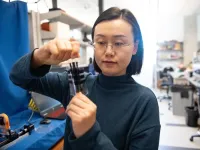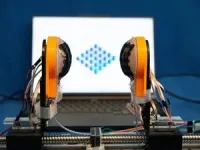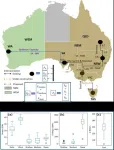(Press-News.org) A first-ever stretchy electronic skin could equip robots and other devices with the same softness and touch sensitivity as human skin, opening up new possibilities to perform tasks that require a great deal of precision and control of force.
The new stretchable e-skin, developed by researchers at The University of Texas at Austin, solves a major bottleneck in the emerging technology. Existing e-skin technology loses sensing accuracy as the material stretches, but that is not the case with this new version.
"Much like human skin has to stretch and bend to accommodate our movements, so too does e-skin," said Nanshu Lu, a professor in the Cockrell School of Engineering's Department of Aerospace Engineering and Engineering Mechanics who led the project. "No matter how much our e-skin stretches, the pressure response doesn't change, and that is a significant achievement."
The new research was published today in Matter.
Lu envisions the stretchable e-skin as a critical component to a robot hand capable of the same level of softness and sensitivity in touch as a human hand. This could be applied to medical care, where robots could check a patient's pulse, wipe the body or massage a body part.
Why is a robot nurse or physical therapist necessary? Around the world, millions of people are aging and in need of care, more than the global medical system can provide.
"In the future, if we have more elderly than available caregivers, it's going to be a crisis worldwide," Lu said. "We need to find new ways to take care of people efficiently and also gently, and robots are an important piece of that puzzle."
Beyond medicine, human-caring robots could be deployed in disasters. They could search for injured and trapped people in an earthquake or a collapsed building, for example, and apply on-the-spot care, such as administering CPR.
E-skin technology senses pressure from contact, letting the attached machine know how much force to use to, for example, grab a cup or touch a person. But, when conventional e-skin is stretched, it also senses that deformation. That reading creates additional noise that skews the sensors' ability to sense the pressure. That could lead to a robot using too much force to grab something.
In demonstrations, the stretchability allowed the researchers to create inflatable probes and grippers that could change shape to perform a variety of sensitive, touch-based tasks. The inflated skin-wrapped probe was used on human subjects to capture their pulse and pulse waves accurately. The deflated grippers can conformably hold on to a tumbler without dropping it, even when a coin is dropped inside. The device also pressed on a crispy taco shell without breaking it.
The key to this discovery is an innovative hybrid response pressure sensor that Lu and collaborators have been working on for years. While conventional e-skins are either capacitive or resistive, the hybrid response e-skin employs both responses to pressure. Perfecting these sensors, and combining them with stretchable insulating and electrode materials, enabled this e-skin innovation.
Lu — who is also affiliated with the Department of Biomedical Engineering, the Chandra Family Department of Electrical and Computer Engineering, the Walker Department of Mechanical Engineering, and the Texas Materials Institute — and her team are now working toward the potential applications. They are collaborating with Roberto Martin-Martin, assistant professor at the College of Natural Sciences' Computer Science Department to build a robotic arm equipped with the e-skin. The researchers and UT have filed a provisional patent application for the e-skin technology, and Lu is open to collaborating with robotics companies to bring it to market.
Other authors on the paper are Kyoung-Ho Ha and Sangjun Kim of the Walker Department of Engineering; Zhengjie Li, Heeyong Huh and Zheliang Wang of the Department of Aerospace Engineering and Engineering Mechanics; and Hongyang Shi, Charles Block and Sarnab Bhattacharya of the Chandra Family Department of Electrical and Computer Engineering. Ha is now a postdoctoral researcher at the Querrey Simpson Institute for Bioelectronics at Northwestern University, and Block is now a doctoral student at the University of Illinois at Urbana-Champaign’s Department of Computer Science.
END
Stretchable e-skin could give robots human-level touch sensitivity
2024-05-03
ELSE PRESS RELEASES FROM THIS DATE:
Researchers collaborate with the shipping industry to cut costs, fuel consumption and greenhouse gas emissions in shipping
2024-05-03
A common challenge in shipping occurs when ships arrive promptly at their destination, only to find a crowded harbour. Subsequently, they are often required to wait outside the harbour or anchor until port services and a quayside become available.
According to a report from the International Maritime Organization (IMO), it is not uncommon for ships to spend between 5-10% of their time waiting to enter port. Excessive speeds followed by extended waiting times with engines running result in a notable increase in fuel consumption. This is a problem that impacts both the climate and the economy.
Several European universities, ports, shipping companies and technology firms have now joined forces ...
Towards transparent and antimicrobial surfaces for touch displays
2024-05-03
The interest in antimicrobial solutions for personal and multi-user touch screens, such as tablets and mobile devices, has grown in recent years. Traditional methods like sprayable alcohols or wipes are not ideal for these delicate displays. Antimicrobial coatings applied directly to the glass are a promising alternative, but only if they are transparent and long-lasting. Previous proposed coating solutions, such as photocatalytic metal oxides (e.g., TiO2 and ZnO), have posed some challenges. Additionally, these coatings typically require light and moisture to be antimicrobial and eliminate the microbes present on the surface.
Copper ...
Number of male Oxbridge students from elite schools declined significantly in the middle of the twentieth century, study shows
2024-05-03
The number of male students at the University of Oxford from elite schools declined significantly by the middle of the twentieth century, a new study shows.
In contrast the proportion of female students remained steady. Those with fathers with professional jobs rose dramatically by the 1960s, according to the analysis.
At the beginning of the century around 25 to 35 per cent had fathers in professional occupations. This had risen to around 50 per cent among those arriving at Oxford in the 1960s.
The research, published in the journal Gender & History, was ...
A cost-efficient path to a renewable energy grid for Australia
2024-05-03
A model charts the most cost-efficient path to a fully renewable electricity grid for Australia. Raheel Ahmed Shaikh and colleagues modeled possible scenarios for Australia’s eastern and western grids, using solar and wind generation, short-to-long-term energy storage, and financial input data to explore low-cost capacity mix. Going completely renewable would require significant expansion of both generation and storage. Interconnecting the two grids would reduce generation capacity needs by 6% and storage power capacity needs by 14%. The least cost renewable-only grid would be dominated by wind, ...
Leadership in MS Rehabilitation recognized: John DeLuca, PhD, awarded 2024 Giants of MS® Honor
2024-05-03
East Hanover, NJ – May 3, 2024 – John DeLuca, PhD, of Kessler Foundation was named recipient of the 2024 Giants of Multiple Sclerosis® award for rehabilitation. He was one of seven inductees announced by NeurologyLive® and the Consortium of Multiple Sclerosis Centers (CMSC) this week. Dr. DeLuca is senior vice president, Research and Training at the Foundation and a professor in the departments of Physical Medicine & Rehabilitation and Neurology at Rutgers New Jersey Medical School.
Established in 2021, the Giants of Multiple Sclerosis award honors trailblazers, innovators, and visionaries ...
High rates of hip osteoarthritis among older adults with spinal deformity
2024-05-03
Waltham — April 30, 2024 — One-third of patients undergoing surgery for adult spinal deformity (ASD) also have severe osteoarthritis (OA) of the hip – which is associated with worse spinal alignment and physical functioning, reports a study in The Journal of Bone & Joint Surgery. The journal is published in the Lippincott portfolio in partnership with Wolters Kluwer.
These differences persist even following operative treatment of ASD, ...
ChatGPT can be helpful for Black women’s self-education about HIV, PrEP
2024-05-03
Waltham — May 3, 2024 — The artificial intelligence (AI) chatbot called ChatGPT is a powerful way for Black women to educate themselves about HIV prevention, as it provides reliable and culturally sensitive information, according to a study in The Journal of the Association of Nurses in AIDS Care (JANAC), the official journal of the Association of Nurses in AIDS Care. JANAC is published in the Lippincott portfolio by Wolters Kluwer.
"In addition to immediately available information, regardless of time or geographic location, privacy ...
Research quantifies “gap” in carbon removal for first time
2024-05-03
New research involving the University of East Anglia (UEA) suggests that countries’ current plans to remove CO2 from the atmosphere will not be enough to comply with the 1.5 ºC warming limit set out under the Paris Agreement.
Since 2010, the United Nations environmental organisation UNEP has taken an annual measurement of the emissions gap - the difference between countries’ climate protection pledges and what is necessary to limit global heating to 1.5 ºC, or at least below 2 ºC.
The ...
Study: ChatGPT displays lower concern for child development “warning signs” than physicians
2024-05-03
Artificial intelligence (AI) tool ChatGPT displayed lower concern than physicians in 36% of potential developmental delays, according to a new study. The research will be presented at the Pediatric Academic Societies (PAS) 2024 Meeting, held May 3-6 in Toronto.
Researchers found ChatGPT made different conclusions about the abnormality of a potential delay than pediatricians 41% of the time.
The study investigated how ChatGPT responded to parents’ concerns whether their child’s development was normal or abnormal, including ...
Study: Childcare is unaffordable for U.S. medical residents
2024-05-03
Resident physicians at more than 98% of U.S. training programs aren’t paid enough to afford childcare, according to a new national study. The research will be presented at the Pediatric Academic Societies (PAS) 2024 Meeting, held May 3-6 in Toronto.
Childcare remains unaffordable even at most programs that subsidize childcare or offer it onsite, the examination of data from the Labor Department and the U.S. Census Bureau’s American Community Survey (ACS) revealed.
“People in the United States from many walks of life struggle to pay for childcare, and resident physicians are no exception,” said Ryan Brewster, MD, resident physician at Boston Children’s ...




